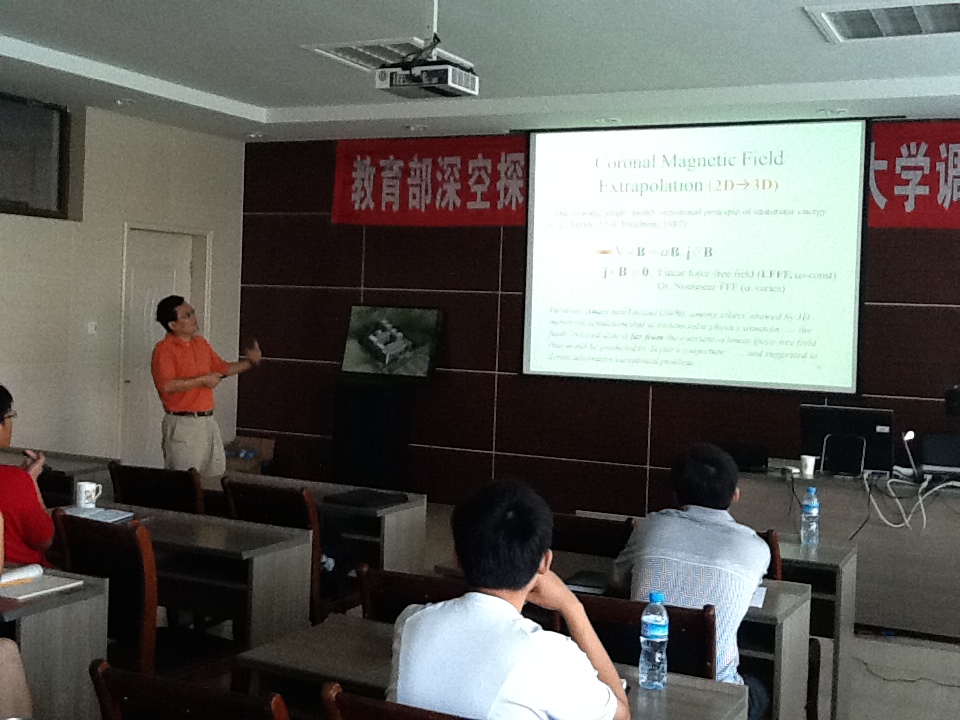
题目1:Non-force-free Extrapolation of Coronal Magnetic Field with Applications to Vector Magnetograms
时间:2011年8月25日(星期四)上午9:10 - 10:30
题目2:Klein-Gordon Equations for Transverse Oscillations in Two-dimensional Coronal Loops
时间:2011年8月25日(星期四)下午2:40 - 4:10
主讲:胡强博士
地点:学术报告厅
报告简介:
报告1:
Motivated by increasingly more advanced solar observations, we recently develop a method of non-force-free extrapolation of the solar coronal magnetic field from vector magnetograms, especially those for a finite active region. Based on a more complex variational principle, the principle of minimum (energy) dissipation rate (MDR), we adopt and solve a more complex equation governing the coronal magnetic field that is non-force-free in general. We describe the theoretical basis in the context of general solar atmosphere conditions, and derive the extrapolation approach utilizing vector magnetograms as bottom boundary conditions. We illustrate the approach using both MHD numerical simulation results, and real vector magnetograph measurements of solar active regions. We wish to establish the validity of our approach, especially by detailed inter-comparison with self-consistent, full MHD simulation results, and investigations of the dynamics associated with non-vanishing forces. In addition, the extension of the method to the whole solar sphere requiring full-disk vector magnetogram will be discussed.
报告2:
We present a theory for hydromagnetic waves in an axi-symmetric background magnetic field in which the wave equations for the transverse magnetic field and velocity perturbations can be transformed into Klein-Gordon (KG) equations. For harmonic time variations, the KG equations become a set of ordinary differential equations that can be solved along any individual field line, subject to boundary conditions at the two ends. The solutions provide the spatial (latitudinal) profiles of the transverse magnetic field and velocity oscillations along the field line. In particular, we examine the KG solutions for two background field geometries: a local dipole field line, and a stretched global dipole field line which may approximate coronal loop geometries in the solar corona. The results yield the oscillation frequencies in agreement with observations (periods of a few minutes), and the spatial profiles which are characteristic of a propagating type near the center of the loop and a possible evanescent/decaying type towards the footpoints of the loop. The latter solution arises when the oscillation frequency is less than a critical cut-off frequency which varies spatially along the loop. The oscillation amplitude is also affected by a adiabatic growth/decay factor along the loop. We discuss the implications of our results and future applications to coronal loop oscillations.
报告人简介:
Dr. Qiang Hu received his Ph.D. in Engineering Sciences from Thayer School of Engineering,DartmouthCollegein 2001, working on analyzing spacecraft data, characterizing near-Earth space environment. He went on to undertake a postdoctoral study at Bartol Research Institute, theUniversityofDelaware, working on the ACE spacecraft data set. From 2004 to 2009, he was appointed as an assistant professional researcher at theInstituteofGeophysicsand Planetary Physics at theUniversityofCalifornia,Riverside. He joined the CSPAR, UAHuntsville in March 2009. He has over 10 years' experience on space plasma environment research, specializing in spacecraft data analysis and modeling. He has been awarded several NASA and NSF grants on studying the interplanetary magnetic and plasma structures, and the magnetic field structure of the solar atmosphere. He is actively diversifying his research experience and pursuing additional opportunities in sponsored research.
